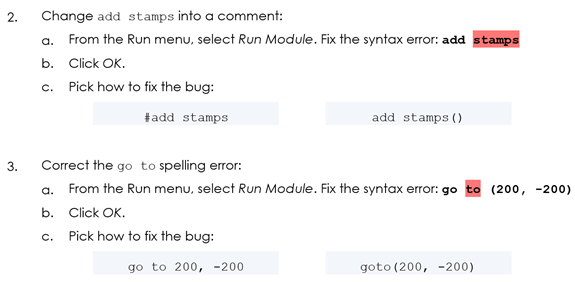When designing a Python programming unit, include lessons with techniques to teach debugging strategies. Debugging is the ability to find and fix errors in code. It is a vital skill for young programmers to master.
Don’t hope that students will discover these strategies on their own. Instead, guide them through proven methods.
Explicit Strategy Instruction and Debugging Strategies
STEM classes emphasize writing code to animate objects, create artwork, or build games. In the push to build a program, the ability to edit the code may not be a focus of instruction. In this learning environment, identifying mistakes and correcting them becomes an implicit process.
During programming lessons, students need to decipher the meaning of error codes independently. They must spontaneously determine how to solve the problem. The young programmer can be left feeling inadequate as they struggle to get their programs to run.
Frustration is an integral part of the learning process. It fosters persistence, which is an admirable quality in a programmer. However, for many beginners, the challenges can seem insurmountable and they give up – telling themselves, “I am not good at programming”.
There is a better way!
Explicitly teaching debugging strategies empowers learners. No longer will they feel defeat when an error message appears. Instead, they have techniques to competently debug the Python program. This builds confidence and promotes a positive attitude towards STEM.
4 Techniques to Teach Debugging Strategies
1. Break It, Repair It
There are many techniques to teach debugging strategies. One that is very effective is to intentionally break code, then run the program to notice the result. This type of STEM lesson takes very little instructional time, yet quickly improves debugging skills.
To start, provide students with a Python file. Using direct instruction, have them systematically delete parts of the code to generate common errors. When the program is run, the instant feedback forms a connection between bugs, error messages, and how to fix the problem.
Some suggestions for breaking the code include:
- remove vital lines such as the import of a library to note how commands are no longer recognized
- add or delete punctuation such as quotes, brackets, colons, and commas to explore their purpose
- adjust the indent level of a block of instructions to see how it influences the program
- alter symbols such as ==, !=, <, and > then study how they alter the output
- misspell a command to highlight the importance of accuracy when typing code
- turn an equal sign == into = to notice how the code no longer works
Using these techniques to teach debugging strategies will enhance your students’ programming skills. If you are looking for a ready-made Python lesson, TechnoTurtle has a Bug Zapper exercise. Students follow instructions to produce bugs and then repair the code. This activity is ideal for beginners in Grades 3-9.

2. Code and Correct
Another debugging lesson is one that guides students through the development of a program. Using direct instruction, the teacher outlines the goal of the programming task. Line by line, the teacher types the code that the students copy. After each line, students run the program to study the output. When a mistake occurs, the teacher highlights the issue and explains how to troubleshoot the code. Slowly, the program takes shape.
This technique best suits students that are familiar with syntax and name errors. Instead of focusing on typos, this lesson emphasizes the quality of the output. It studies the outcome and provides solutions on how to improve the code. The sample program should be short. It must have common pitfalls to resolve as a class.
TechnoTurtle, a Python programming project for beginners, has several lessons that are ideal for a Code and Correct lesson. For example, students follow steps to draw a robot. Throughout the learning process, problems are intentionally generated. This provides an opportunity for beginners to think about the code and how to improve the program’s design.

3. Explore and Investigate
Invite exploration into your STEM lessons to promote a positive attitude towards debugging. Often troubleshooting a program’s output can be a source of frustration. However, in this activity it is fun. Encourage students to play with different values to notice how they change the outcome. Investigate by making a number higher or lower. Or, replace a string with another option.
Explore and Investigate is meaningful. Active discovery demonstrates why one value is better suited to the program than another. It transforms mistakes into happy surprises.
Sparking a life-long interest in STEM is one of the goals of programming lessons. In TechnoTurtle, there are many activities in which students modify the values within a program to achieve a unique outcome. This makes learning enjoyable, which hopefully promotes an on-going interest in programming.

4. Pick the Correct Code
Another technique to improve debugging skills is to provide students with snippets. Rather than mindlessly copying code they are presented with two options. One snippet is correct, the other has a bug. By making choices, the young programmers write the program.
This type of programming lesson actively engages students. They must study the code and think about the choice they will make. If they are incorrect, the feedback is instant. They can then use the other option instead. This activity cultivates a learning environment where it is safe to make mistakes.
An example of a similar programming activity is Clean Up the Code in TechnoTurtle. Young programmers determine how to debug the code. The program they are editing should stamp turtles on the canvas. However, it has four errors. For each error, they are given two choices. This activity builds debugging skills.

Apply Multiple Techniques to Teach Debugging Strategies
When teaching your next programming unit, design lessons that explicitly teach debugging strategies. This will build competence in your students and support independent learning. As well, this instructional approach has the potential to transform how students feel about errors. Turn your STEM classroom into a safe place to make mistakes.
